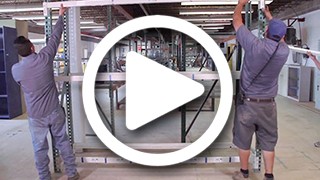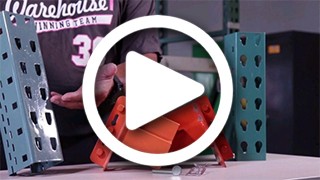Warehouse Management Software: What You Need to Know
In today's fast-paced business environment, efficient warehouse management is crucial for companies of all sizes. Warehouse Management Software (WMS) has become an essential tool for optimizing operations, reducing costs, and improving customer satisfaction. This article will help answer your questions about what it takes to implement a warehouse management system.

Do I Need a Warehouse Management System?
Before diving into the details of WMS implementation, it's important to determine if your company actually needs one. Here are some key indicators that suggest a WMS could benefit your business:
 Inventory Inaccuracies: If you're experiencing frequent stock discrepancies or struggling to maintain accurate inventory counts, a WMS can help improve accuracy and visibility. Effectively managing your stock levels is a key process in effective inventory control.
Inventory Inaccuracies: If you're experiencing frequent stock discrepancies or struggling to maintain accurate inventory counts, a WMS can help improve accuracy and visibility. Effectively managing your stock levels is a key process in effective inventory control.- Inefficient Picking Processes: Inefficient picking wastes time. A Warehouse Management System (WMS) helps your team find items quickly. It reduces walking distances. This improves order completion and overall efficiency reducing or eliminating time consuming processes that could put you behind schedule.
- High Error Rates: Dealing with frequent shipping errors or customer complaints about incorrect orders? A WMS can help reduce mistakes and improve customer order accuracy.
- Limited Visibility: Do you know the health of your inventory or warehouse operations? Do you know your fulfillment rates, or do you need help tracking KPIs? A WMS will provide all the visibility you need to provide the informed decisions you need.
- Manual Processes: Are you still using outdated, manual processes and keeping the paper companies in business? Guess what, a WMS can automate most of those tasks, reducing the rate of human error and make you more environmentally responsible.
- Scalability Challenges: Did your startup take off and now your struggling to keep up with the increase in orders? Warehouse management systems can provide improved efficiency for small businesses as well.
Do any of these challenges feel familiar to you or get your blood pressure up? If so then it's likely that a WMS could bring significant improvements to your business.
Why Would I Need a Warehouse Management System?
Implementing a WMS offers numerous benefits that can transform your warehouse operations and positively impact your entire business. Here are some key reasons why you might need a WMS:
 Improved Inventory Accuracy: A WMS provides real-time tracking of inventory levels, locations, and movements, reducing discrepancies and improving overall accuracy.
Improved Inventory Accuracy: A WMS provides real-time tracking of inventory levels, locations, and movements, reducing discrepancies and improving overall accuracy.- Enhanced Operational Efficiency: By optimizing pick routes, automating tasks, and streamlining workflows, a WMS can significantly boost productivity and reduce labor costs, what's that going to do for your bottom line?
- Better Space Utilization: WMS systems can analyze your warehouse layout, suggesting the most efficient placement of your material. This results in better pick times, faster ship times and increased customer satisfaction.
- Increased Order Accuracy: Features like barcode scanning and automated pick lists are only a couple of the invaluable benefits of using one of these systems . Oftentimes it can lead to dramatically reduced pick errors and increased order accuracy.
- Real-time Visibility: A WMS provides instant access to critical information about inventory levels, order status, and warehouse performance, enabling better decision-making.
- Improved Customer Satisfaction: By ensuring faster, more accurate order fulfillment, a WMS can help enhance customer satisfaction and loyalty.
- Regulatory Compliance: Work in an industry where everything you move need to be traceable? a WMS can help maintain detailed records and ensure compliance with any regulations you need to abide by.
- Cost Reduction: Profit is important, which means great processes and low errors should be at the top of your checklist. Using your WMS to its maximum potential will ultimately reduce your costs and make you more profitable.
What Can a Warehouse Management System Do for Me?
A robust WMS offers a wide range of features and capabilities that can transform your warehouse operations. Here are some key functions a WMS can provide:
 Inventory Management: An active inventory system tracks your inventory in real time, monitoring every movement from receiving to shipping. It can also manage your inventory, reducing the risk of stockouts or overstocking. It can do this by predicting when you need to order, and how much you need to order, keeping things moving and customers happy.
Inventory Management: An active inventory system tracks your inventory in real time, monitoring every movement from receiving to shipping. It can also manage your inventory, reducing the risk of stockouts or overstocking. It can do this by predicting when you need to order, and how much you need to order, keeping things moving and customers happy.- Order Fulfillment: Streamline the picking, packing, and shipping processes to improve accuracy and speed up order processing.
- Receiving and Put Away: Automate the receiving process and optimize storage locations for new inventory.
- Labor Management: Track employee performance, assign tasks efficiently, and optimize workforce scheduling.
- Reporting and Analytics: Generate detailed reports on warehouse performance, inventory levels, and other key metrics to inform decision-making.
- Integration: Connect with other business systems like ERP, transportation management, and e-commerce platforms for seamless data flow.
- Mobile Access: Provide warehouse staff with mobile devices for real-time data access and task management on the go.
- Yard and Dock Management: Coordinate inbound and outbound shipments to optimize dock usage and reduce wait times.
- Returns Management: Streamline the returns process, including tracking, inspecting, and restocking returned items.
- Cycle Counting: Facilitate regular inventory counts without disrupting daily operations, improving inventory accuracy.
How Can a WMS Make My Business Better?
Implementing a software solution like a WMS can have far-reaching positive impacts on your business. Here are some ways a WMS can drive improvement:
 Increased Productivity: You'll optimize workflows, automate tasks, and boost warehouse productivity. as well, you'll be able to handle higher volumes with the same or fewer resources.
Increased Productivity: You'll optimize workflows, automate tasks, and boost warehouse productivity. as well, you'll be able to handle higher volumes with the same or fewer resources.- Reduced Costs: Improved efficiency, reduced errors, and better inventory management can lead to substantial cost savings across your operations.
- Enhanced Customer Service: Faster, accurate fulfillment can improve customer satisfaction and loyalty. You work hard to gain your customers trust, which makes it important to keep your warehouse running smoothly.
- Better Decision Making: Real-time visibility into warehouse operations and inventory levels enables more informed decision-making and proactive problem-solving.
- Scalability: As your customer demand grows, your business grows, as this is happening your systems and processes will need to grow as well. A good WMS will be there with you the entire way, providing the tools you need to handle the growth and increased volume.
- Competitive Advantage: We've already talked about how a WMS can improve efficiency & customer service. Did you know it can also provide the competitive edge over competitors that are using manual or outdated systems?
- Improved Supplier Relationships: Better inventory management and receiving processes can lead to smoother interactions with suppliers and potentially better terms.
- Environmental Benefits: Do you consider your operation sustainably friendly? Well Guess what, sustainability is more than just recycling. A WMS can help just by optimizing your processes and error reduction. Less travel = Less wasted energy, reduced errors, reduces waste.
A Warehouse Management Case Study: Beanz n’ Leavz
To illustrate the potential benefits of implementing a WMS, let's look at a real-world example:
Beanz n' Leavz is the world leader in the specialty coffee industry. B&L sources whole beans from the best coffee plantations in the world and roasts them using patented roasting technology. The company sells whole bean and ground coffee along with freshly brewed espresso style beverages, cookies, pastries, candy and allied accessories and equipment via its numerous retail stores throughout the world.
B&L decided to replace its paper-based Warehouse Management System (WMS) and implement the Oracle Warehouse Management System in its Memphis facility. The company brought in a team of consultants to analyze the operations, propose an implementation plan and recommend how the new warehouse management can increase throughput.
Oracle's case study demonstrates how a well-implemented WMS can drive significant improvements across multiple areas of warehouse operations and overall business performance.
A link to the case study can be found here.
WMS Software Options
While there are no shortages of WMS solutions available in the market, they range from basic systems, suitable for small businesses to complex, feature-rich platforms for large enterprises. Here are some popular options:
 SAP Extended Warehouse Management: A comprehensive solution suitable for large enterprises with complex warehouse operations.
SAP Extended Warehouse Management: A comprehensive solution suitable for large enterprises with complex warehouse operations.- Oracle Warehouse Management Cloud: A cloud-based system offering robust features and scalability for businesses of various sizes.
- Manhattan Associates Warehouse Management: A feature-rich solution known for its advanced capabilities and industry-specific functionality.
- Infor Supply Chain Execution: A flexible system that integrates warehouse, labor, and transportation management.
- Korber Warehouse Management: A scalable solution offering both cloud and on-premise deployment options.
- Fishbowl Warehouse: A popular choice for small to medium-sized businesses, offering integration with QuickBooks.
- Logiwa WMS: A cloud-based system designed specifically for e-commerce and multi-channel retailers.
- Extensiv 3PL Warehouse Manager: A solution tailored for third-party logistics providers.
With so many different solutions for warehouse management systems available, it's important to consider factors such as your business size, industry, specific requirements, budget, and existing technology stack, and most of all does it work for what your business wants to accomplish.
Average Cost to Implement a WMS System
The cost of implementing a WMS is going to vary depending on factors such as the size of your business, the complexity of your operations, the features you need and how you want to deploy. Below is a general overview of potential costs:
 Software Licensing: For cloud-based systems, subscription costs can start around $5,000 per year for small businesses and can range up to $200,000 or more per year for large enterprises with complex needs.
Software Licensing: For cloud-based systems, subscription costs can start around $5,000 per year for small businesses and can range up to $200,000 or more per year for large enterprises with complex needs.- Implementation: Implementation costs, including system configuration, data migration, and training, can range from $10,000 for small, simple setups to $250,000 or more for large, complex implementations.
- Hardware: Will you need to purchase new hardware (like mobile devices, barcode scanners, or servers for on-premise systems), costs can range from a few thousand dollars to $100,000 or more.
- Ongoing Support and Maintenance: Annual support and maintenance fees typically range from 15% to 20% of the initial software license cost.
- Training: While often included in implementation costs, additional training may be necessary and can cost several thousand dollars.
For a small to medium-sized business, the total first-year cost of implementing a WMS might range from $50,000 to $250,000. For large enterprises with complex needs, costs can easily exceed $1 million.
Please note that while these costs may seem significant, the potential return on investment (ROI) from improved efficiency, reduced errors, and better inventory management can often justify the expense.
WMS Implementation Checklist
Before deciding to implement a WMS, it's crucial to assess your readiness and clearly define your needs. Here's a link to a comprehensive WMS implementation checklist that can guide you through this process:

WMS Implementation Checklist
This checklist covers key areas such as:
- Defining your requirements
- Assessing your current processes
- Evaluating potential vendors
- Planning for data migration
- Preparing for system integration
- Training your staff
- Testing the system
By working through this checklist, you can ensure you're well-prepared for a successful WMS implementation.
Conclusion
Implementing a Warehouse Management System can be a game-changer for businesses of all sizes, offering significant improvements in efficiency, accuracy, and customer satisfaction. While the process requires careful planning and investment, the potential benefits of cost savings, improved operations, and competitive advantage can far outweigh the initial costs.
As you consider whether a WMS is right for your company, take the time to thoroughly assess your needs, research different solutions, and prepare your organization for the changes that come with implementing new technology and more efficient supply chain management. With the right approach, a WMS can become a powerful tool for driving your business forward in today's competitive marketplace.



